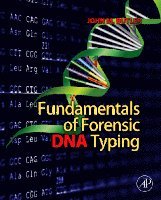
- Format
- Häftad (Paperback / softback)
- Språk
- Engelska
- Antal sidor
- 520
- Utgivningsdatum
- 2009-09-30
- Förlag
- Elsevier Science Publishing Co Inc
- Dimensioner
- 235 x 191 x 28 mm
- Vikt
- Antal komponenter
- 1
- ISBN
- 9780123749994
- 894 g
Fundamentals of Forensic DNA Typing
- Skickas från oss inom 7-10 vardagar.
- Fri frakt över 249 kr för privatkunder i Sverige.
Passar bra ihop
De som köpt den här boken har ofta också köpt Braiding Sweetgrass av Robin Wall Kimmerer (häftad).
Köp båda 2 för 668 krKundrecensioner
Fler böcker av John M Butler
-
Understanding Forensic DNA
Suzanne Bell, John M Butler, Suzanne Bell, John M Butler
-
Advanced Topics in Forensic DNA Typing: Methodology
John M Butler, John M Butler
-
Forensic DNA Typing
John M Butler
-
Advanced Topics in Forensic DNA Typing: Interpretation
John M Butler
Recensioner i media
"There is perhaps no individual better suited to author a foundational survey of forensic DNA typing than John Butler. As with past editions, Butler's knowledge, along with his organizational and communication skills make Fundamentals of Forensic DNA Typing a must read for students, forensic practitioners and trial attorneys. This text provides the reader with insightful and understandable explanations necessary to comprehend the underpinnings of forensic DNA analysis. It continues in the tradition of its predecessors as the premier textbook on the forensic DNA subject."
-- Richard Saferstein, Ph.D. Author and Forensic Science Consultant
"When ScienceWatch.com, a Thomson Reuters web resource for measuring and analyzing science trends, recently listed the most influential institutions and researchers in forensic science based on journal citations, the National Institute of Standards and Technology (NIST) and one of its researchers, John Butler, were among the leaders."
-- ThomasNet.com
"Intended as the companion to the 2010 publication, Fundamentals of Forensic DNA Typing, this title contains 18 chapters with four appendices providing up-to-date coverage of essential topics in the field of DNA analysis. The book includes new information on DNA databases, low-level DNA, and validation; a comprehensive listing of alleles for the 23 STR loci present in commercial kits, and coverage of familial searching."
--Evidence Technology Magazine, July-August 2012, page 4
Övrig information
John M. Butler is a NIST Fellow and Special Assistant to the Director for Forensic Science, Office of Special Programs, at the U.S. National Institute of Standards and Technology, in Gaithersburg, Maryland. Dr. Butler earned his PhD from the University of Virginia while doing DNA research in the FBI Laboratory's Forensic Science Research Unit. He has won numerous scientific awards, including being named Science Watch's #1 world-wide high-impact author in legal medicine and forensic science over the last decade (July 2011). He has over 150 publications in this field and is a frequent presenter on the topic of DNA typing, and has authored four other DNA Typing books including Advanced Topics in Forensic DNA Typing: Methodology. For a detailed CV, visit http://www.cstl.nist.gov/strbase/butler.htm.
Innehållsförteckning
Foreword
Introduction
Acknowledgments
About the author
1 Overview and History of DNA Typing
2 Basics of DNA Biology and Genetics
3 Historical Methods
4 Sample Collection, Storage and Characterization
5 DNA Extraction
6 DNA Quantitation
7 DNA Amplification (The Polymerase Chain Reaction)
8 Short Tandem Repeat Markers
9 Fundamentals of DNA separation and Detection
10 STR Genotyping and Data Interpretation
11 Statistical Interpretation: Evaluating the Strength of Forensic DNA Evidence
12 DNA databases
13 Quality Assurance
14 Forensic Challenges: Degraded DNA, Mixtures, and LCN
15 Additional Loci and Non-Human DNA Testing
16 Lineage Markers: Y Chromosome and mtDNA Testing
17 Applications of DNA Typing
18 Future Trends
Appendix
1 Glossary of Terms
2 Useful Websites
3 Probability and Statistics
Du kanske gillar
-
Proto
Laura Spinney
Häftad -
Nexus
Yuval Noah Harari
Häftad


